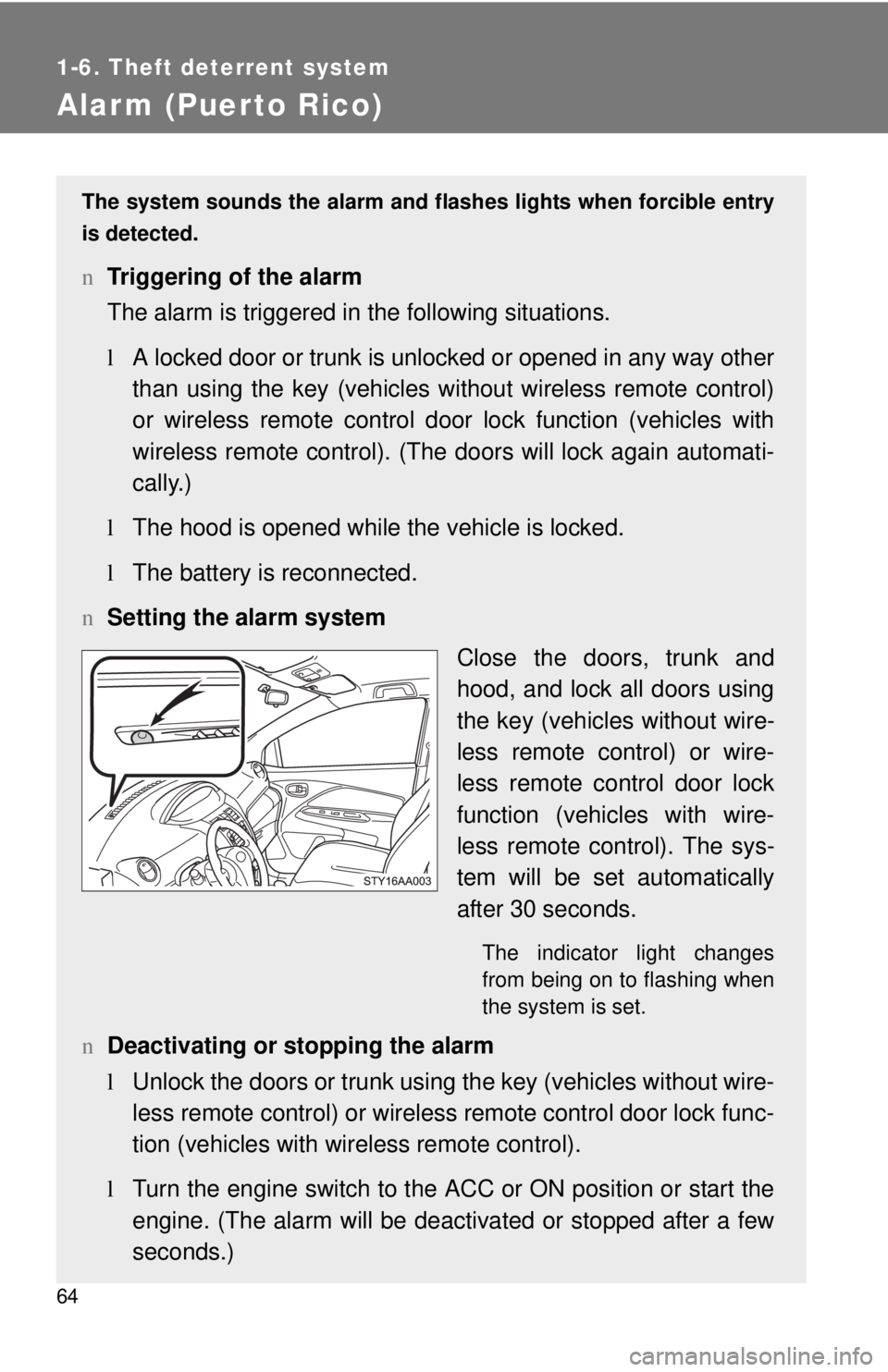Page 40 of 386

26
1-2. Opening, closing and locking the doors
Wireless remote control∗
∗: If equipped
nOperation signals
The emergency flashers flash to indicate that the doors have been locked/
unlocked. (Locked: Once; Unlocked: Twice)
nPanic mode
nKey battery depletion
The standard battery life is 1 to 2 years. (The battery becomes depleted
even if the key is not used.) If the wireless remote control function does not
operate, the battery may be depleted. Replace the battery when necessary.
(→P. 261)
n Security feature
If a door is not opened within approximately 30 seconds after the vehicle is
unlocked, the security feature automatically locks the vehicle again.
The wireless remote control can be used to lock/unlock the vehicle
from outside the vehicle.
Locks all doors
Sounds alarm
(push and hold)
Unlocks all doors
Pressing the button unlocks
the driver’s door. Pressing the
button again within 3 seconds
unlocks the other doors.
When is pushed for longer than about
1 second, an alarm will sound for about
60 seconds and the vehicle lights will
flash to deter any person from trying to
break into or damage your vehicle.
To stop the alarm, push any button on the
wireless remote control.
Page 78 of 386

64
1-6. Theft deterrent system
Alarm (Puerto Rico)
The system sounds the alarm and flashes lights when forcible entry
is detected.
n Triggering of the alarm
The alarm is triggered in the following situations.
lA locked door or trunk is unlocked or opened in any way other
than using the key (vehicles without wireless remote control)
or wireless remote control d oor lock function (vehicles with
wireless remote control). (The doors will lock again automati-
cally.)
l The hood is opened while t he vehicle is locked.
l The battery is reconnected.
n Setting the alarm system
Close the doors, trunk and
hood, and lock all doors using
the key (vehicles without wire-
less remote control) or wire-
less remote control door lock
function (vehicles with wire-
less remote control). The sys-
tem will be set automatically
after 30 seconds.
The indicator light changes
from being on to flashing when
the system is set.
nDeactivating or stopping the alarm
lUnlock the doors or trunk using the key (vehicles without wire-
less remote control) or wireless remote control door lock func-
tion (vehicles with wireless remote control).
l Turn the engine switch to the ACC or ON position or start the
engine. (The al arm will be deactivated or stopped after a few
seconds.)
Page 79 of 386

65
1-6. Theft deterrent system
1
Before driving
n
System maintenance
The vehicle has a maintenance-free type alarm system.
n Items to check before locking the vehicle
To prevent unexpected triggering of the alarm and vehicle theft, make sure
of the following.
lNobody is in the vehicle.
l The windows are closed before the alarm is set.
l No valuables or other personal items are left in the vehicle.
n Triggering of the alarm
The alarm may be triggered in the following situations.
(Stopping the alarm deactivates the system.)
lA person inside the vehicle opens a door, the trunk or hood.
l The battery is recharged or replaced when the vehicle is locked.
n When the battery is disconnected
Be sure to deactivate the alarm system.
If the battery is discharged before deactivating the alarm system, the alarm
may be triggered when the battery is reconnected.
NOTICE
nTo ensure the system operates correctly
Do not modify or remove the system. If modified or removed, the proper
operation of the system cannot be guaranteed.
Page 126 of 386
113
2-1. Driving procedures
2
When driving
CAUTION
n
Caution while driving
Do not turn the engine switch to the LOCK position.
If in an emergency, you must turn the engine off while the vehicle is moving,
turn the engine switch only to the ACC position.
NOTICE
nTo prevent battery discharge
Do not leave the engine switch in the ACC or ON position for long periods if
the engine is not running.
n When starting the engine
lDo not crank for more than 30 seconds at a time. This may overheat the
starter and wiring systems.
l Do not race a cold engine.
l If the engine becomes difficult to start or stalls frequently, have the engine
checked immediately.
Page 144 of 386
131
2-3. Operating the lights and wipers
2
When driving
n
Daytime running light system (if equipped)
lTo make your vehicle more visible to other drivers, the headlights turn on
automatically (at a reduced intensity) whenever the engine is started and
the parking brake is released. Daytime running lights are not designed for
use at night.
l Compared to turning on the headlights, the daytime running light system
offers greater durability and consumes less electricity, so it can help
improve fuel economy.
n Light reminder buzzer
A buzzer sounds when the key is removed and the driver’s door is opened
while the lights are turned on.
NOTICE
nTo prevent battery discharge
Do not leave the lights on longer than necessary when the engine is not run-
ning.
Page 161 of 386

148
2-5. Driving information
Winter driving tips
Carry out the necessary preparations and inspections before driving
the vehicle in winter. Always drive the vehicle in a manner appropri-
ate to the prevailing weather conditions.
n Pre-winter preparations
lUse fluids that are appropriate to the prevailing outside tem-
peratures.
• Engine oil
• Engine coolant
• Washer fluid
l Have a service technician inspect the level and specific grav-
ity of battery electrolyte.
l Have the vehicle fitted with four snow tires or purchase a set
of tire chains for the front tires.
Ensure that all tires are the same size and brand, and that chains
match the size of the tires.
nBefore driving the vehicle
Perform the following according to the driving conditions.
lDo not try to forcibly open a window, scrape an outside rear
view mirror surface or move a wiper or outside rear view mir-
ror that is frozen. Pour warm water over the frozen area to
melt the ice. Wipe away the water immediately to prevent it
from freezing.
l To ensure proper operation of th e climate control system fan,
remove any snow that has accumulated on the air inlet vents
in front of the windshield.
l Remove any ice that has accumu lated on the vehicle chassis.
l Periodically check for and remove any excess ice or snow
that may have accumulated in the wheel well or on the
brakes.
Page 181 of 386

169
3-1. Using the air conditioning system
and defogger
3
Interior features
nUsing the system in recirculated air mode
The windows will fog up more easily if the recirculated air mode is used for
an extended period.
n When outside air temperature approaches 32°F (0°C)
The air conditioning system may not operate even when
is pressed.
n When
is selected for the air outlets used
For your driving comfort, air flowing to the feet may be warmer than air flow-
ing to the upper body depending on the position of the temperature adjust-
ment dial.
n Air conditioning odors
lDuring use, various odors from inside and outside the vehicle may enter
into and accumulate in the air conditioning system. This may then cause
odor to be emitted from the vents.
l To reduce potential odors from occurring:
It is recommended that the air conditioning system be set to outside air
mode prior to turning the vehicle off.
CAUTION
nTo prevent the windshield from fogging up
Do not set the air outlet selection dial to during cool air operation in
extremely humid weather. The difference between the temperature of the
outside air and that of the windshield can cause the outer surface of the
windshield to fog up, blocking your vision.
NOTICE
nTo prevent battery discharge
Do not leave the air conditioning system on longer than necessary when the
engine is stopped.
Page 183 of 386
171
3-1. Using the air conditioning system
and defogger
3
Interior features
NOTICE
nTo prevent battery discharge
Do not leave the rear window defogger on longer than necessary when the
engine is stopped.